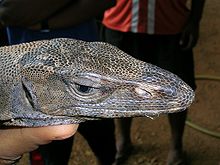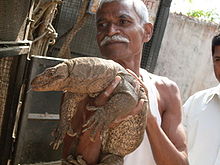- Bengal monitor
-
Bengal Monitor (Indian Monitor) 
Bengal Monitor Lizard Scientific classification Kingdom: Animalia Phylum: Chordata Class: Reptilia Order: Squamata Suborder: Lacertilia Family: Varanidae Genus: Varanus Subgenus: V. (Empagusia) Species: V. bengalensis Binomial name Varanus bengalensis
(Daudin, 1802)Synonyms Tupinambis bengalensis
The Bengal monitor (Varanus bengalensis) or common Indian monitor, is a monitor lizard found widely distributed over South Asia. This large lizard is mainly terrestrial, and grows to about 175 cm from the tip of the snout to the end of the tail. Young monitors may be more arboreal, but adults mainly hunt on the ground, preying mainly on arthropods, but also taking small terrestrial vertebrates, ground birds, eggs and fish. Although large monitors have few predators apart from humans who hunt them for meat, younger individuals are hunted by many predators.
Contents
Description
 Common Indian monitor Varanus bengalensis in Hyderabad, India
Common Indian monitor Varanus bengalensis in Hyderabad, India
The Bengal monitor has been said to reach nearly 175 cm with a snout-to-vent length (SVL) of 75 cm and a tail of 100 cm. Males are generally larger than females. Heavy individuals may weigh nearly 7.2 kg.[1] The populations of India and Sri Lanka differ in the scalation from those of Myanmar, and these were once considered two species, but now considered two subspecies. The nominate subspecies is found west of Myanmar, while nebulosus is found to the east. The subspecies nebulosus is diagnosed by the presence of a series of enlarged scales in the supraocular region. The number of ventral scales varies, decreasing from 108 in the west (Pakistan) to 75 in the east (Java).[2]
Young monitor lizards are more colourful than adults. Young have a series of dark crossbars on the neck, throat and back. The belly is white, banded with dark crossbars and are spotted with grey or yellow (particularly in the eastern part of the range). On the dorsal surface of young monitors, there are a series of yellow spots with dark transverse bars connecting them. As they mature, the ground colour becomes light brown or grey, and dark spots give them a speckled appearance. Hatchlings of nebulosus tend to have a series of backward-pointing, V-shaped bands on their necks.[3]
Bengal monitors have external nostril openings (nares) that is slit-like and oriented near horizontal, and positions between the eye and the tip of the snout. The nares can be closed at will, especially to keep away debris or water.[4] The scales of the skin are rougher in patches and on the sides, they have minute pits, especially well distributed in males.[5] These scales with micropores have glandular structures in the underlying dermal tissue and produce a secretion which may be a pheromone-like substance. Like other varanids, Bengal monitors have a forked tongue that is protruded in the manner of snakes. The function is mainly sensory, and is not very involved in the transport of food down the throat. Bengal monitors have fat deposits in the tail and body that serve them in conditions when prey are not easily available.
The lungs have spongy tissue unlike the sacs of other saurians. This allows for greater rates of gas exchange and allows a faster metabolic rate and higher activity levels. Like all varanids, they have subpleurodont teeth, meaning the teeth are fused to the inside of the jaw bones.[6] The teeth are placed one behind another, and there are replacement teeth behind and between each functional tooth (polyphyodont). The maxillary and dentary teeth are laterally compressed, sometimes with a slightly serrate cutting edge, while the premaxillary teeth are conical. There are 78 premaxillary teeth, 10 maxillary and 13 dentary teeth. Replacement teeth move forward and about four replacements happens each year for a tooth.[7] Their mandibular glands produce secretions at the base of the teeth, and although some varanids have been shown to have a venom, no toxicity has been reported in the Bengal monitor.[8]
Distribution and habitat
The species ranges from Iran to Java, among the most widely distributed of varanid lizards. It is found in river valleys in eastern Iran, Afghanistan, Pakistan, India, Nepal, Sri Lanka, Bangladesh and Burma. The subspecies Varanus bengalensis nebulosus, the clouded monitor, occurs in southern Burma, Vietnam, Cambodia, Thailand, Malaysia, Sumatra, Java and the Sunda Islands. They have not been confirmed on Sumatra, and have been found to be absent from the Andaman Islands.[9]
The species is distributed mainly in the lower elevations, and is found both in dry semiarid desert habitats to moist forest. They are often found in agricultural areas, and are mainly found below 1500m altitude.[10]
Ecology and behaviour
Bengal monitors are usually solitary and usually found on the ground, although the young are often seen on trees. V. b. nebulosus has a greater propensity for tree climbing. Bengal monitors shelter in burrows they dig or crevices in rocks and buildings, whilst clouded monitors prefer tree hollows. Both races will make use of abandoned termite mounds. Bengal monitors, like other varanids, show true sleep at night and are diurnal, becoming active around 6 AM and bask in the morning sun.[11] During winter, in the colder parts of their distribution range, they may take shelter and go through a period of reduced metabolic activity.[12] They are not territorial, and may change their range seasonally in response to food availability.[13]
They are usually shy and avoid humans. They have keen eyesight and can detect human movement nearly 250 m away. When caught, a few individuals may bite, but rarely do so.[14]
Captives have been known to live for nearly 22 years.[15] Predators of adults include pythons, mammalian predators and birds. A number of ectoparasites and endoparasites are recorded.
Breeding
Females may be able to retain sperm, and females held in confinement have been able to lay fertile eggs.[16] Varanus niloticus has been demonstrated to be capable of parthenogenesis. The main breeding season is June to September. Males, however, begin to show combat behaviour in April. Females dig a nest hole in level ground or a vertical bank and lay the eggs inside, filling it up and using their snouts to compact the soil. The females often dig false nests nearby and shovel soil around the area. They sometimes make use of a termite mound to nest. A single clutch of about 20 eggs are laid. The eggs hatch in 168 to nearly as long as 254 days.[17] About 40 to 80% of the eggs may hatch.
Locomotion
They are capable of rapid movement on the ground. Small individuals may climb trees to escape, but larger ones prefer to escape on the ground. They can climb well. On the ground, they sometimes stand on the hind legs to get a better view or when males fight other males.[18] They can also swim well and can stay submerged for at least 17 minutes.[19]
Food
Large adults may ascend vertical tree trunks, where they sometimes stalk and capture roosting bats. Their normal prey consists of beetles, grubs, orthopterans, scorpions, snails, ants and other invertebrates. Vertebrate prey is comparatively rare, and includes frogs, fish, lizards, snakes and rodents. They sometimes feed on dead animals.[20] In areas where livestock are common, they often visit dung, where they forage for beetles and other insects.[21]
In culture
The lizard is known as bis-cobra in western India, guishaap or goshaap in West Bengal and Bangladesh, and as ghorpad in Maharashtra. Folk belief has it that they are venomous, and in Sri Lanka their breath is believed to be poisonous. In Rajasthan, they are believed to be venomous only during the rainy season.[22] These lizards have strong claws they use for climbing. A popular legend has it that Shivaji's general, Tanaji Malusare, used a monitor with ropes attached for climbing the walls of the Sinhagad fort in the Battle of Sinhagad.
Monitor lizards are hunted, and their body fat, extracted by boiling, is used in a wide range of folk remedies.[23]
Notes
- ^ Komododragon.biz
- ^ Auffenberg (1994):24
- ^ Auffenberg (1994):39
- ^ Auffenberg (1994):22
- ^ Auffenberg (1994):36
- ^ Auffenberg (1994):50
- ^ Auffenberg (1994):51
- ^ Auffenberg (1994):58
- ^ Auffenberg (1994):86
- ^ Auffenberg (1994):103-118
- ^ Auffenberg (1994):138-145
- ^ Auffenberg (1994):147
- ^ Auffenberg (1994):175
- ^ Auffenberg (1994):182
- ^ Auffenberg (1994):180
- ^ Auffenberg (1994):221
- ^ Auffenberg (1994):230-247
- ^ Auffenberg (1994):183
- ^ Auffenberg (1994):185
- ^ Auffenberg (1994):267
- ^ Auffenberg (1994):349
- ^ Auffenberg (1994):58
- ^ Auffenberg (1994):appendix
References
- Auffenberg, Walter (1994). The Bengal Monitor. University Press of Florida. p. 494. ISBN 0813012953.
- Auffenberg, W. 1979 Intersexual differences in behaviour of captive Varanus bengalensis. J.Herpet. 13(3):313-315.
- Auffenberg, W. 1979 Research on monitor lizards. Tiger Paper 6(4):20-21.
- Auffenberg, W. 1981 Combat behaviour in Varanus bengalensis. J.Bombay N.H.S. 78(1):54-72.
- Auffenberg, W. 1983 The burrows of Varanus bengalensis. Rec. Zool. Surv. India 80:375-385.
- Auffenberg, W. 1983 Courtship behaviour in Varanus bengalensis. In Advances in Herpetology and Evolutionary Biology: Essays in Honor of Ernest E. Williams (Rhodin & Myata eds.): 535-551.
- Auffenberg, W. 1983 Notes on feeding behaviour of Varanus bengalensis. J. Bombay N.H.S. 80 (2): 286-302.
- Auffenberg, W. 1986. The Indian monitor lizard. Sanctuary Asia. 6 (4):327-333.
- Mertens, R. 1942. Ein weiterer neuer Warane aus Australien. Zool. Anz. 137: 41-44
External links
Varanoidea Kingdom: Animalia · Phylum: Chordata · Class: Reptilia · Order: Squamata Extant species Argus monitor · Black tree monitor · Bengal monitor · Black-spotted Ridge-tailed Monitor · Crocodile monitor · Desert Monitor · Dumeril's monitor · Emerald tree monitor · Gray's monitor · Kalabeck's monitor · Kimberley Rock Monitor · Komodo dragon · Lace monitor · Mangrove monitor · Mertens' Water Monitor · Nile monitor · Peacock monitor · Peach Throat Monitor · Perentie · Rock monitor · Pilbara monitor · Rennell Island Monitor · Rosenberg's Monitor · Short-tailed monitor · Spiny-tailed monitor · Timor tree monitor · Turquoise monitor · Sand goanna · Savannah monitor · Water monitor · Yellow MonitorRelated categoriesMonitor lizards · Cretaceous lizards · Helodermas · MosasaursFossil species DolichosauridaeHelodermatidaeVaranidaeCategories:- Monitor lizards
- Reptiles of Asia
- Reptiles of India
- Reptiles of Nepal
- Reptiles of Sri Lanka
- Reptiles of Bangladesh
- Reptiles of Burma
- Reptiles of Laos
- Reptiles of Vietnam
- Reptiles of Cambodia
- Reptiles of Thailand
- Reptiles of Malaysia
- Reptiles of Brunei
- Reptiles of Indonesia
Wikimedia Foundation. 2010.



